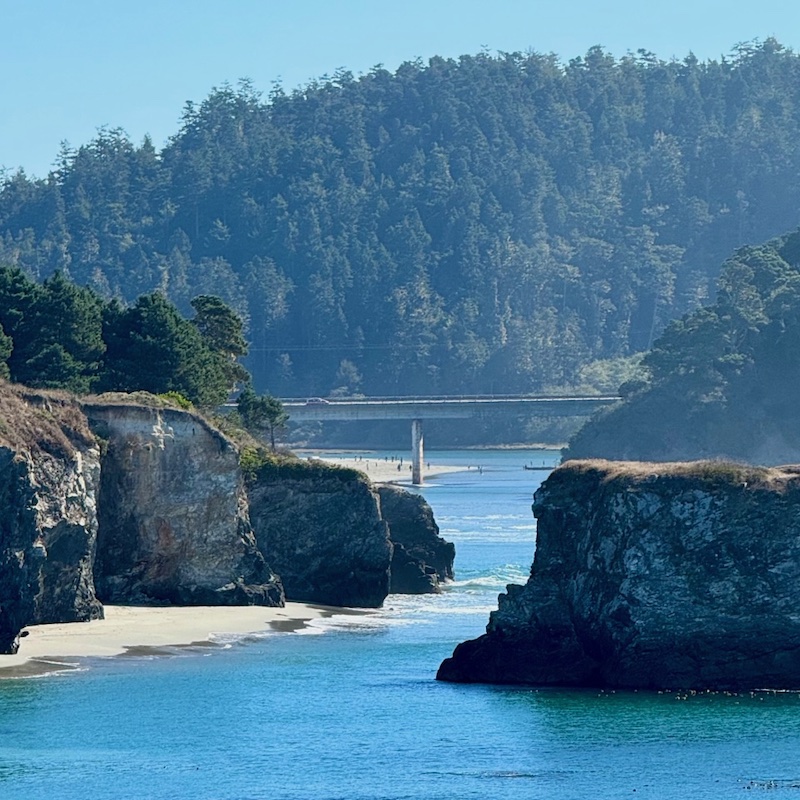November 4, 1961 – The fifth Big River Bridge officially opened with a dedication ceremony. The bridge had already been in use for two weeks so that workmen could begin demolishing the old bridge which had been in service since 1924. Unlike previous Big River bridges, the new bridge was elevated with a 47-foot clearance above the water, while the approaches to the earlier bridges were on the flat.
The bridge dedication was sponsored by the Mendocino Lions Club and took place in the afternoon at the north bridgehead. Ted Watkins, the president of the club, extended a warm welcome, and William B. Larkin served as master of ceremonies. George Thompson, chairman of the dedication committee, was assisted by his fellow club members Floyd Strelow, Reo Strelow, Robert Graham, and Glen Walbridge.

The Fifth Big River Bridge, 2023. (Photographer: Robert Dominy)
John H. Philbrick, chairman of the county planning commission, sketched in for his listeners a brief history of bridges and transportation across Big River, from the days of the ferry in the 1850s and the early 1860s to the first bridge built across Big River in 1864 by William H. Kent. This bridge operated as a toll bridge under the management of the firm of Coombs, Stickney, and Perkins. Philbrick’s father, a Civil War veteran, arrived in Mendocino in 1866, worked at the mill for 12 hours during the day, and served as toll taker at night.
Tolls at the time were 50 cents for a 6-horse team and driver, 15 cents for a single horse and rider, 5 cents for each head of cattle, and 2 cents for each sheep. In 1878, the County bought the toll bridge for $3,500, and crossing Big River Bridge became free.
By 1882, the first bridge was deemed unsafe, and the board of supervisors awarded Pacific Bridge Company a $4,949 contract to build a new bridge. By 1899, this bridge was so weak that heavy cargo could not be hauled across safely.
The third Big River Bridge opened in August 1899 at a cost of $7,793. This bridge was plagued with problems: severe storms often washed away its foundation, part of the bridge dropped into the river during the 1906 earthquake, and a heavy tractor fell through the bridge and landed on the beach in 1921. A new bridge was constructed in 1924 to replace that trouble-prone structure.
By the late 1950s, the fourth bridge was in need of repairs and considered too narrow for modern traffic. Plans were made for a new Big River Bridge as part of the realignment of State Highway 1 along the coast. Construction of the fifth bridge, which is still in use in 2023, began in the summer of 1960.
Celebrate the 50th anniversary of Mendocino Historical Research Inc., now known as the Kelley House Museum. Meet founders Dorothy Bear and Beth Stebbins, who moved to Mendocino, fell in love with local history, then galvanized a community to establish a research center to preserve the town’s many stories and artifacts. On display are some of the earliest donations made to MHRI: census records from the 1860s, clothing from the Kelley family, the Ford family’s Bible, materials from Bear & Stebbins’ first exhibit “Mendocino Homes,” Anne Kendall Foote’s bespoke wallpaper reproductions, and photographs of the activists whose labor restored the house and whose contributions have supported the Kelley House over the years. 45007 Albion Street, Mendocino. Thursday-Monday, 11am – 3pm. Now until February 26.